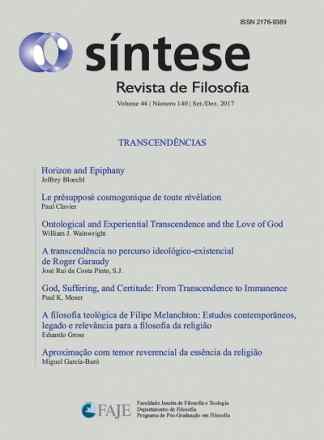SER INICIADO AO AMOR - AS RELAÇÕES ENTRE CULTOS DE MISTÉRIO E PANDÉIA A PARTIR DO BANQUETE DE PLATÃO
Síntese
SER INICIADO AO AMOR - AS RELAÇÕES ENTRE CULTOS DE MISTÉRIO E PANDÉIA A PARTIR DO BANQUETE DE PLATÃO
Autor Correspondente: Carlos Roberto Loredo | [email protected]
Palavras-chave: Cultos de Mistérios, Paidéia platônica, O Banquete, eros.
Resumos Cadastrados
Resumo Português:
O texto do Banquete de Platão faz várias referências, diretas e indiretas, a cultos gregos de Mistério do perÃodo clássico, a saber, os Mistérios de Elêusis, DionisÃacos e Órficos. O objetivo deste artigo é, partindo destas referências, mostrar as relações existentes entre os cultos de Mistério e a paidéia de Platão e analisar o significado destas relações. Para tanto, apresentaremos uma caracterização da religiosidade mistérica em geral e aspectos especÃficas dos três Mistérios supra citados; depois apresentaremos a visão platônica de eros no Banquete e a proposta de paidéia que está subjacente a ela para, então, caracterizar as três relações que podemos inferir que há entre paidéia platônica e Mistérios, a partir da análise do Banquete, ou seja, as relações de homologia teleológica, homologia estrutural e distinção metodológica. Por fim, abordaremos o significado destas relações.
Resumo Inglês:
Plato’s Banquet, makes, directly or indirectly, several references to the Greek Mystery cults of the Classical period, that is, the Eleusians, Dionysiac and Orphic Mysteries. Using the above references as a starting point, this paper aims at showing the existing relationships between the Mystery cults and Plato’s paideia, and analyzing the significance of such relationships. We will therefore present a general characterization of mysteric religiosity as well as some specific aspects of the three Mysteries mentioned above. Then, we will introduce the Platonic vision of Eros in the Banquet and the proposal of a paideia that underlies such a vision. This analysis of the Banquet will help characterize the three relationships that can be inferred between Platonic paideia and the Mysteries, that is to say, the relationships of teleological homology, structural homology and methodological distinction. Finally, we will approach the significance of theses relationships.

